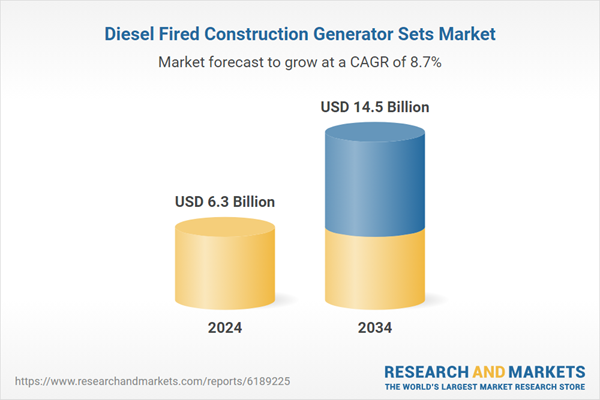Increasing regulatory pressure for cleaner energy technologies and the strong focus on fuel efficiency and cost optimization are shaping market growth. Construction companies are moving toward next-generation diesel gensets that combine reliability with improved environmental compliance. These generators remain indispensable across large and small construction projects, offering dependable off-grid power for operations where electrical grid access is limited or inconsistent. Diesel fired generator sets are engineered to supply continuous energy to run equipment, lighting, and temporary on-site installations, ensuring uninterrupted workflow even in remote or challenging environments. Designed to withstand rugged field conditions, these systems deliver consistent performance and longevity, meeting the operational needs of demanding construction activities. The transition toward advanced, high-efficiency diesel systems is gaining traction as industries seek sustainable solutions without compromising performance. Their growing application in infrastructure, transportation, and large-scale construction projects continues to strengthen market expansion, as uninterrupted energy remains critical to safety and productivity on-site.
The >50 kVA - 125 kVA power range segment will reach USD 1.5 billion by 2034. Rising demand stems from their flexibility and capability to support mid-scale construction projects such as commercial complexes, roads, and maintenance works. These generator sets offer steady and dependable power to operate critical equipment including pumps, mixers, and material handling systems, making them highly suitable for multi-shift construction operations where performance and uptime are key considerations.
The standby construction generator segment is projected to grow at a CAGR of 8% from 2025 to 2034. The demand surge is primarily driven by the need for reliable emergency backup systems that automatically activate during power failures caused by grid disruptions or adverse weather events. Permanently installed on construction sites, these systems ensure operational continuity and site safety by maintaining essential power supply during outages. With the increasing frequency of extreme weather conditions and rising dependency on electrically powered machinery, the adoption of standby gensets has become a strategic necessity for maintaining productivity across projects of varying sizes.
U.S. Diesel Fired Construction Generator Sets Market held 85% share in 2024, generating USD 904.3 million. The country’s construction industry relies heavily on continuous power availability to run heavy machinery, cranes, lighting systems, and other critical on-site infrastructure. Recurring grid instabilities, power interruptions, and severe weather patterns have heightened the importance of robust and efficient on-site power systems. As a result, diesel gensets remain the most preferred option across diverse construction projects due to their durability, reliability, and readiness to deliver instant power.
Key players in the Global Diesel Fired Construction Generator Sets Market include Wärtsilä, Caterpillar, Cummins, Mahindra Powerol, Sterling Generators, Greaves Cotton, Sudhir Power, Atlas Copco, Rolls-Royce, FG Wilson, Aggreko, HIMOINSA, Rehlko, Mitsubishi Heavy Industries, J C Bamford Excavators, Kirloskar, Ashok Leyland, Generac Power Systems, Jakson, and Supernova Genset. Companies in the Diesel Fired Construction Generator Sets Market are pursuing multiple strategies to expand their competitive reach and reinforce market leadership. Major players are investing in advanced engine technologies to enhance fuel efficiency, reduce emissions, and ensure compliance with tightening global regulations. Product diversification remains a core strategy, with companies developing compact and hybrid-ready gensets for flexible applications across construction sites. Collaborations with construction contractors and rental service providers help expand distribution networks and improve customer access to customized power solutions. Firms are also leveraging digital monitoring systems and predictive maintenance tools to enhance operational reliability and minimize downtime.
Comprehensive Market Analysis and Forecast
- Industry trends, key growth drivers, challenges, future opportunities, and regulatory landscape
- Competitive landscape with Porter’s Five Forces and PESTEL analysis
- Market size, segmentation, and regional forecasts
- In-depth company profiles, business strategies, financial insights, and SWOT analysis
This product will be delivered within 2-4 business days.
Table of Contents
Companies Mentioned
The companies profiled in this Diesel Fired Construction Generator Sets market report include:- Aggreko
- Ashok Leyland
- Atlas Copco
- Caterpillar
- Cummins
- FG Wilson
- Generac Power Systems
- Greaves Cotton
- HIMOINSA
- Jakson
- J C Bamford Excavators
- Kirloskar
- Mahindra Powerol
- Mitsubishi Heavy Industries
- Rehlko
- Rolls-Royce
- Sterling Generators
- Sudhir Power
- Supernova Genset
- Wärtsilä
Table Information
| Report Attribute | Details |
|---|---|
| No. of Pages | 214 |
| Published | October 2025 |
| Forecast Period | 2024 - 2034 |
| Estimated Market Value ( USD | $ 6.3 Billion |
| Forecasted Market Value ( USD | $ 14.5 Billion |
| Compound Annual Growth Rate | 8.7% |
| Regions Covered | Global |
| No. of Companies Mentioned | 21 |









